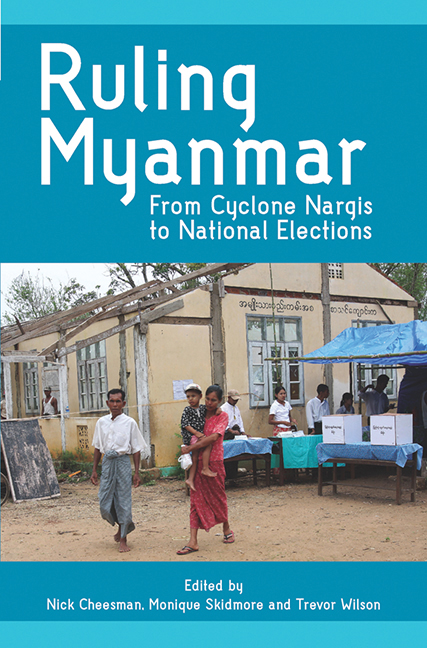Book contents
- Frontmatter
- Contents
- List of Tables
- List of Figures
- Background on ANU 2009 Myanmar/Burma Update Conference
- Acknowledgements
- Contributors and Editors
- Note on Terminology and Geographical Names
- Map of Myanmar
- Part I Overview
- Part II Political Legitimacy, Governance and Justice
- Part III Economic Development, the Rural Economy and Labour Rights
- 7 Myanmar's Response to the 2008 Global Financial Crisis
- 8 Recapitalizing Burma's Rural Credit System
- 9 Farmers, Land and Military Rule in Burma
- 10 The Movement of Rural Labour: A Case Study Based on Rakhine State
- Part IV The Role of International Cooperation and Governance
- List of Abbreviations
- Index
7 - Myanmar's Response to the 2008 Global Financial Crisis
from Part III - Economic Development, the Rural Economy and Labour Rights
Published online by Cambridge University Press: 21 October 2015
- Frontmatter
- Contents
- List of Tables
- List of Figures
- Background on ANU 2009 Myanmar/Burma Update Conference
- Acknowledgements
- Contributors and Editors
- Note on Terminology and Geographical Names
- Map of Myanmar
- Part I Overview
- Part II Political Legitimacy, Governance and Justice
- Part III Economic Development, the Rural Economy and Labour Rights
- 7 Myanmar's Response to the 2008 Global Financial Crisis
- 8 Recapitalizing Burma's Rural Credit System
- 9 Farmers, Land and Military Rule in Burma
- 10 The Movement of Rural Labour: A Case Study Based on Rakhine State
- Part IV The Role of International Cooperation and Governance
- List of Abbreviations
- Index
Summary
INTRODUCTION
Some studies suggest that the Myanmar government spending will remain heavily focused on military expenditure, with few (if any) initiatives in the pipeline to support households and businesses or to stimulate the economy in the face of the global economic downturn. The Myanmar government announced that the current global economic slowdown has had only a marginal impact on Myanmar. It seems doubtful, however, that it would be capable of taking effective action to limit damage, as indicated by the speeches of military leaders and articles in the daily papers.
In an article entitled “Resilient Country, Resilient People”, which appeared in the New Light of Myanmar on 18 December 2008, Kyaw Ye Min (the pseudonym of an official) claimed that Myanmar had suffered no spill-over effects from the crisis of neighbouring Southeast Asian countries during the Asian financial crisis in 1997. Myanmar, he said, was capable of managing the economy to stabilize it and of isolating itself from economic crises in other countries. A country without any external aid and help could survive easily in the face of difficulties, it was assumed.
In 2003, Myanmar experienced a banking crisis. Problems in subprime financial services infected banks, creating a liquidity crisis. To make things worse, rumours spread which influenced people to withdraw their deposits. Some private banks had a poor record of financial discipline and depositors had a low level of trust and confidence in Myanmar's banks. The government provided 59.90 billion kyat of credit to banks as emergency liquidity during this period. In addition, as a lender of last resort, the central bank extended a credit line of a further 50.68 billion kyat. With a total of 110.58 billion s given to thirteen private banks, the banks recovered by January 2004, which was an indication, the article said, that the Myanmar government was willing and capable of helping people in times of need and emergency.
To help victims of Cyclone Nargis, which left Irrawaddy Division and Yangon Division helpless in May 2008, subsidies of 88.44 billion kyat were provided by the government, with 42.32 billion kyat more coming from private donors. Even if Myanmar is a poor country, the help from government should be recognized, the columnist added.
- Type
- Chapter
- Information
- Ruling MyanmarFrom Cyclone Nargis to National Elections, pp. 115 - 125Publisher: ISEAS–Yusof Ishak InstitutePrint publication year: 2010



